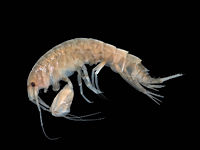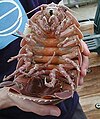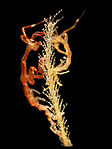Portal:Crustaceans
The Crustaceans Portal Crustaceans are a group of arthropods that are a part of the subphylum Crustacea (/krəˈsteɪʃə/), a large, diverse group of mainly aquatic arthropods including decapods (shrimps, prawns, crabs, lobsters and crayfish), seed shrimp, branchiopods, fish lice, krill, remipedes, isopods, barnacles, copepods, opossum shrimps, amphipods and mantis shrimp. The crustacean group can be treated as a subphylum under the clade Mandibulata. It is now well accepted that the hexapods (insects and entognathans) emerged deep in the Crustacean group, with the completed group referred to as Pancrustacea. The three classes Cephalocarida, Branchiopoda and Remipedia are more closely related to the hexapods than they are to any of the other crustaceans (oligostracans and multicrustaceans). The 67,000 described species range in size from Stygotantulus stocki at 0.1 mm (0.004 in), to the Japanese spider crab with a leg span of up to 3.8 m (12.5 ft) and a mass of 20 kg (44 lb). Like other arthropods, crustaceans have an exoskeleton, which they moult to grow. They are distinguished from other groups of arthropods, such as insects, myriapods and chelicerates, by the possession of biramous (two-parted) limbs, and by their larval forms, such as the nauplius stage of branchiopods and copepods. Most crustaceans are free-living aquatic animals, but some are terrestrial (e.g. woodlice, sandhoppers), some are parasitic (e.g. Rhizocephala, fish lice, tongue worms) and some are sessile (e.g. barnacles). The group has an extensive fossil record, reaching back to the Cambrian. More than 7.9 million tons of crustaceans per year are harvested by fishery or farming for human consumption, consisting mostly of shrimp and prawns. Krill and copepods are not as widely fished, but may be the animals with the greatest biomass on the planet, and form a vital part of the food chain. The scientific study of crustaceans is known as carcinology (alternatively, malacostracology, crustaceology or crustalogy), and a scientist who works in carcinology is a carcinologist. (Full article...) Selected article
Caprella mutica, commonly known as the Japanese skeleton shrimp, is a species of skeleton shrimp. It is a relatively large caprellids, reaching a maximum length of 50 mm (2.0 in). The species is sexually dimorphic, with the males usually being much larger than the females. It is characterised by their "hairy" first and second thoracic segments and the rows of spines on their bodies. Body colour ranges from green to red to blue, depending on the environment. It is an omnivorous, highly adaptable, opportunistic feeder. In turn, it provides a valuable food source for fish, crabs, and other larger predators. C. mutica is usually found in dense colonies attached to submerged man-made structures, floating seaweed, and other organisms.
C. mutica is native to shallow protected bodies of water in the Sea of Japan. In as little as 40 years, it has become an invasive species in the North Atlantic, North Pacific, and along the coasts of New Zealand. It is believed to have been accidentally introduced to these areas through the global maritime traffic and aquaculture. Outside of its native range, C. mutica is often exclusively synanthropic, being found in large numbers in and around areas of human activity. Its ecological and economic impact as an invasive species is unknown, but it poses a serious threat to native populations of skeleton shrimp in the affected areas. Did you know?
Selected biography
Charles Chilton (1860–1929) was a New Zealand zoologist, the first rector to be appointed in Australasia, and the first person to be awarded a D.Sc. degree in New Zealand.
Chilton was born on September 27, 1860 at Little Marstone, Pencombe (near Leominster, Herefordshire, England) but emigrated with his family to New Zealand in 1862. They settled on a farm at East Eyreton, North Canterbury. He was troubled by his hips from an early age, and had his left leg amputated, using an artificial leg and a crutch thereafter. In 1881, he gained an M.A. with first class honours from Canterbury College, having been taught by Frederick Wollaston Hutton, who inspired him to take up biology, especially the study of crustaceans, which had been little studied in New Zealand up to that time. Chilton's first scientific publication followed that same year, when he described three new species of crustacean (two crabs and one isopod) from Lyttelton Harbour and Lake Pupuke. He surprised the scientific world later that year by describing four species of amphipod and isopod from groundwaters at the family farm in Eyreton. He went on to discover the isopod Phreatoicus typicus in the same location, the first example ever described of the suborder Phreatoicidea, the "earliest derived isopod[s]". Charles Chilton became rector of Christchurch University College in 1921, the first time such a post had been granted in Australia or New Zealand. Chilton died on October 25, 1929 of a sudden attack of pneumonia, before he could collect his life's work into a single monograph. He had published 130 papers on crustaceans, mostly amphipods, isopods and decapods, from all around the world, but especially from New Zealand, subterranean and sub-Antarctic waters. Selected image Chthamalus stellatus is a barnacle found in the Atlantic Ocean from Shetland to southern Europe. General imagesThe following are images from various crustacean-related articles on Wikipedia.
Crustacean lists
SubcategoriesRelated portalsWikiProjectsAssociated WikimediaThe following Wikimedia Foundation sister projects provide more on this subject:
Discover Wikipedia using portals
|






















































